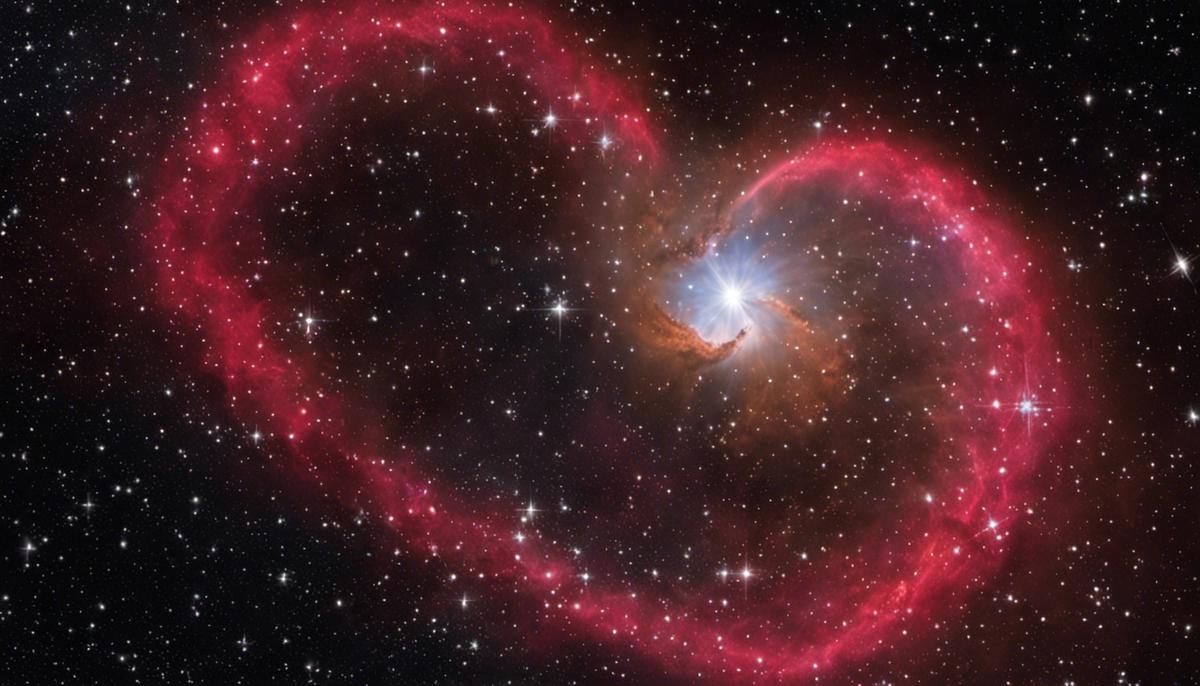Stars have always piqued the curiosity of humans, sparking countless tales, mythologies, and astronomical studies across civilizations. To decipher the secrets hidden in the vast expanse of the cosmos, one needs to understand the fundamentals of stars, particularly their brightness or magnitude. The magnitude of a star is instrumental in classifying its significance, a concept that will become clearer as we delve into the mysteries of Antares, the brightest star in the constellation of Scorpius. Teeming with rich history, mythological significance, and noteworthy celestial bodies, the constellation of Scorpius canvasses a fascinating cosmic tapestry in the night sky. At its heart lies Antares, a star that stands out in this constellation for its radiant glow.
Understanding Star Magnitudes
Understanding Star Magnitudes
Star magnitudes are a measure of a star’s brightness as seen from Earth. The magnitude scale is logarithmic, which means that each increase in number represents a substantial decrease in light. The most intuitive aspect of this scale is that a star of the first magnitude is roughly 2.5 times brighter than a star of a second magnitude.
The scale originated with the ancient Greek astronomer Hipparchus, who designated the brightest stars as stars of the first magnitude, or „first class.“ Today, modern observational techniques have expanded the scale to include stars brighter than first magnitude and stars that are fainter than sixth magnitude, which were the limits of Hipparchus’s scale.
Measurement of Star Magnitudes
Magnitude is divided into two categories: apparent and absolute. Apparent magnitude refers to the brightness of a star as observed from Earth, taking into account the star’s inherent brightness and its distance from us. The closer a star is to us, the brighter it appears.
Absolute magnitude, on the other hand, envisions all stars being observed from a standard distance of 10 parsecs (32.6 light-years). This provides a direct comparison of brightness and doesn’t take into account the distance of the star.
Significance of Star Magnitudes
The magnitude of a star provides key insights about its physical characteristics. For instance, brighter stars tend to be either larger in size, hotter in temperature, or both. Furthermore, the study of star magnitudes can also help in understanding the lifespan and the ultimate fate of stars.
Unveiling the Brilliance of Antares: Scorpius’ Brightest Star
Unquestionably the most luminous star in the constellation of Scorpius, Antares possesses an apparent magnitude of +1.0. Its intriguing moniker stems from Ancient Greece and translates to „Mars’ rival,“ a label befitting its striking reddish hue. This color associates it with Mars while drawing attention to its classification as a red supergiant. Despite being one of the largest known stars—with a radius a staggering 680 times that of our Sun—Antares’ considerable distance of roughly 550 light-years from Earth makes it appear dimmer from our viewpoint.
Designated as a slow irregular variable star, Antares experiences slight fluctuations in its magnitude as its brightness shifts over time. This fascinating behavior compels us to further understand star magnitudes, enabling us to observe and contextualize the unique features of Antares and other stellar bodies. Essentially, the magnitude of a star divulges valuable insights into its physical attributes and how it’s perceived from our terrestrial perspective.

Overview of Scorpius Constellation
Scorpius Constellation: An Astronomical Showcase
Best remembered on Earth as Scorpio, the constellation of Scorpius holds an esteemed place among the zodiac constellations prominent in astrology. Its name is rooted in Latin and symbolizes a scorpion, drawing parallels to its vibrant place in ancient mythology. The daring tale recounts Orion, the Greek god, who asserted he could kill any earthly creature. Responding to his arrogance, Gaia, the Earth Goddess, unleashed a venomous scorpion that eventually felled Orion. To memorialize this epic, Zeus etched both Orion and the scorpion onto our night sky, culminating in the Orion and Scorpius constellations we recognize today.
Embracing a pivotal role in the tapestry of the Milky Way galaxy, the Scorpius constellation is neatly nestled near the galaxy’s center, adjacent to the Sagittarius constellation. Owing to its closeness to the equator, Scorpius is a familiar sight in night skies around the globe, making it one of the most frequently sighted constellations.
The Brightest Star in Scorpius: Antares
Antares is the brightest star in the constellation of Scorpius and is often referred to as the „Heart of the Scorpion.“ Its name, Antares, originates from Ancient Greece and signifies „rival of Mars,“ due to its reddish appearance that rivals that of Mars. Ranked as the sixteenth brightest star visible from Earth, Antares is a red supergiant that has about 12 to 18 times the mass of our Sun, and a radius more than 680 times larger.
This star is also notable for its variability in brightness as it is a semi-regular variable star. This characteristic implies that its brightness changes, but not at regular intervals or predictable patterns. As an outcome of this phenomenon, there can be shifts in Antares’ apparent visual magnitude, which ranges from about +0.6 to +1.6.
In addition to Antares, other prominent stars in the Scorpius constellation include Shaula, Sargas, and Dschubba. While these stars are not as bright as Antares, they are still notable for their size, luminosity, or historical significance. Together with Antares, they paint a celestial picture of the lethal, yet entrancing, scorpion that is held in the heavens.
Cultural and Astrological Importance of Scorpius
Scorpius, an influential constellation beyond its astronomical features, holds deep cultural and astrological significance. This constellation was recognized and incorporated into the traditional lore of several civilizations globally. Take ancient Egypt, for example, when the constellation Scorpius would become visible in the early morning sky before sunrise, signaling the onset of the Nile floods.
Switching to astrology, Scorpius forms the basis for the Scorpio zodiac sign. The perceived attributes of Scorpio, including bravery, passion, and resourcefulness, reflect the intrepid, powerful nature of the scorpion represented in the stars.
To summarize, Scorpius and its luminary star, Antares, skillfully weave a fascinating narrative of tales, symbols, and scientific intrigue, serving as a beacon of enlightenment for humanity throughout the ages.

Antares: The Brightest Star in Scorpius
Antares: The Heart of Scorpius
The most radiant star in the constellation Scorpius, Antares, often carries the appellation „heart of the scorpion.“ It’s named Antares originating from the combination of the Ancient Greek words „anti“ representing „against“ and „Ares“, the ancient Greek God of War (synonymous with Mars in the Roman mythology). Epitomizing its notable red hue, the nomenclature alludes to its resemblance with the planet Mars in the night sky.
Understanding the Star’s Anatomy
Designated as a supergiant star, Antares is an aging celestial body finishing out its stellar lifespan. It’s considered a class M star, which means it’s cool compared to other stars with its reddish appearance resulting from the lower temperatures of its outer layers. Despite being “cool” in stellar terms, its temperature still averages a scorching 3,500 degrees Celsius, or over 6,300 degrees Fahrenheit.
Antares is a massive star, ranking approximately 12th in size when compared to other known stars. Its diameter is about 700 times larger than the sun. To put that into perspective, if you were to place Antares at the center of our solar system, it would extend beyond the orbit of Mars.
Location and Viewability
The Scorpius constellation, home to Antares, is one of the zodiac constellations named by ancient Greeks. It resides in the southern hemisphere and for viewers in the Northern Hemisphere, Scorpius appears low on the southern horizon in the summer months. The best time to view Antares and its constellation is in July around 9 p.m., although it can be seen from April through November.
Scientific Importance and Research
Antares is not just popular for its brightness but also for its contributions to science. It is a slow variable star, which means that it has a somewhat erratic variability in brightness. This variability has enabled astronomers to learn about the star’s size and internal structure.
In addition, Antares is a binary star, having a companion star, Antares B, in its orbit whose blue-green color contrasts sharply with its bigger, red neighbor. The study of Antares and its companion helps astronomers understand different stages of stellar evolution.
Cultural Significance
Stars, including Antares, play noticeable roles in various cultures because of their distinct characteristics. In ancient Greek lore, Scorpius and its brightest star Antares represent the scorpion that killed the hunter Orion, and this celestial scorpion still chases Orion across the sky in our seasonal star movement. In other societies, Antares stands for a core celestial emblem like the „Heart of the Sky“ in the Hawaiian star lore.

Embracing an understanding of star magnitudes, an overview of the Scorpius constellation, and a specific examination of the star, Antares, our journey through the cosmos becomes an enlightening affair. Each shimmering light in the sky holds a story, a scientific marvel to unmask. Antares, the brightest star in Scorpius, is no exception. Its extraordinary features, from size to intrinsic brightness, make it a stellar specimen in our night sky. As we continue to explore the vast corners of our universe, remember that even a single star, like Antares, can shed substantial light on the astonishing intricacies of the cosmos.
